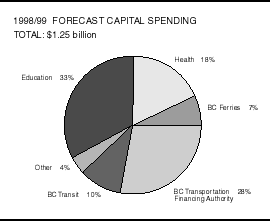Borrowing for capital projects finances the building of schools, hospitals, roads, and other forms of provincial infrastructure. These investments provide essential services for today and will also benefit future generations of British Columbians.
The need for capital infrastructure in British Columbia is substantial. Maintaining the existing asset base, replacing aging infrastructure, and meeting the needs of a growing and changing population all require capital spending. The Financial Management Plan provides discipline to ensure that only the highest-priority capital projects proceed, and that government pursues innovative and cost-effective mechanisms to provide capital infrastructure.
Review of 1997/98 Capital Spending
In 1997/98, approximately $975 million was spent to finance capital projects including the building of schools, hospitals, roads and other forms of provincial infrastructure. Specific examples of projects undertaken in 1997/98 include:
- 7,300 new spaces were constructed for children in the kindergarten to grade 12 system;
- construction of the Kiwanis Care Centre (192 multi-level care bed facility) in North Vancouver;
- construction of the Diagnostic and Treatment Centre in Hudson's Hope;
- construction of the new cancer treatment centre in Kelowna;
- continued construction of the Vancouver Island Highway; and
- completion of the TRIUMF laboratory in Vancouver.
1998/99 Capital Spending
For 1998/99, government will be increasing the level of capital spending to approximately $1.25 billion, an increase of about $275 million from 1997/98. The increase in capital spending, including the carry-over of delayed projects from 1997/98, will provide some economic stimulus during 1998/99. The major portions of capital spending will be on education, and on highway construction and upgrades. Examples of projects for 1998/99 include:
- a new 650-student Summit Middle School in Coquitlam;
- a new 425-student Somerset Elementary School in Pitt Meadows;
- other school expansion projects to reduce the number of portables;
- major renovations to the University College of the Cariboo in Kamloops;
- expansion of the Centre for Molecular Medicine and Therapeutics in Vancouver;
- replacement of the Royal Jubilee Hospital Diagnostic and Treatment Centre in Victoria;
- construction of the Juan de Fuca Priory (75 multi-level care bed facility) in Victoria;
- construction of Trans Canada Highway high-occupancy vehicle lanes in Burnaby;
- road improvement projects (rehabilitation) throughout the province;
- widening of the Trans Canada Highway from Hospital Road to 30th Street in Salmon Arm and from the Tumbleweed Interchange to Senora in Kamloops;
- continued construction on the Vancouver Island Highway;
- continued construction of the new fast ferries with the first ferry to be completed in 1998; and
- purchase of additional and replacement buses throughout the province.
Economic Growth
As well as meeting the capital needs of the province, capital spending also assists in stimulating the economy. Capital spending in 1997/98 created an estimated 12,400 person-years of employment in the design and construction industry. In 1998/99, the additional $275 million in capital spending will create an estimated 3,700 more jobs than in 1997/98.
Capital Review Update
In June 1996, the government announced a review of capital expenditures to determine the appropriate levels of investment and to improve the planning, construction, and maintenance of infrastructure. The review concluded in January 1997 and identified over 100 potential cost containment strategies, falling into four categories:
- developing program delivery models which require less capital investment;
- maximizing the use of existing assets;
- acquiring capital in the most efficient and cost-effective manner possible; and
- pursuing alternative financing options.
For 1997/98, the projected value of the cost containment strategies totalled $200 million. The value of the cost containment strategies is projected to approach $275 million in savings in 1998/99.
Examples of cost containment strategies and their savings value in 1997/98 include:
- $57 million as a result of space standard and unit rate reductions in the kindergarten to grade 12 system;
- $53 million through increased utilization of existing space in the post-secondary system;
- $4 million through alternative financing of long-term care beds;
- $4 million through group purchasing of hospital equipment; and
- $11 million through intergovernmental cost-shared highway projects.
In 1997/98, the government also began pursuing several alternative procurement methods including:
- design-build of the Penticton Hospice and the Sechelt Area Elementary School;
- construction management of the Summit Middle School in Coquitlam; and
- integrated project management of the North Fraser Pre-trial Correctional Centre in Port Coquitlam.
The government is reorganizing the way social capital projects are delivered in 1998/99. While needs assessment and planning remain the responsibility of individual ministries, project management, financing, and project delivery are consolidated in the Ministry of Finance and Corporate Relations. The objective of this new model is to achieve greater savings by increasing joint and multi-use facilities, public-private partnership opportunities and utilization of existing facilities, and undertaking more cost-effective and efficient procurement methods.
